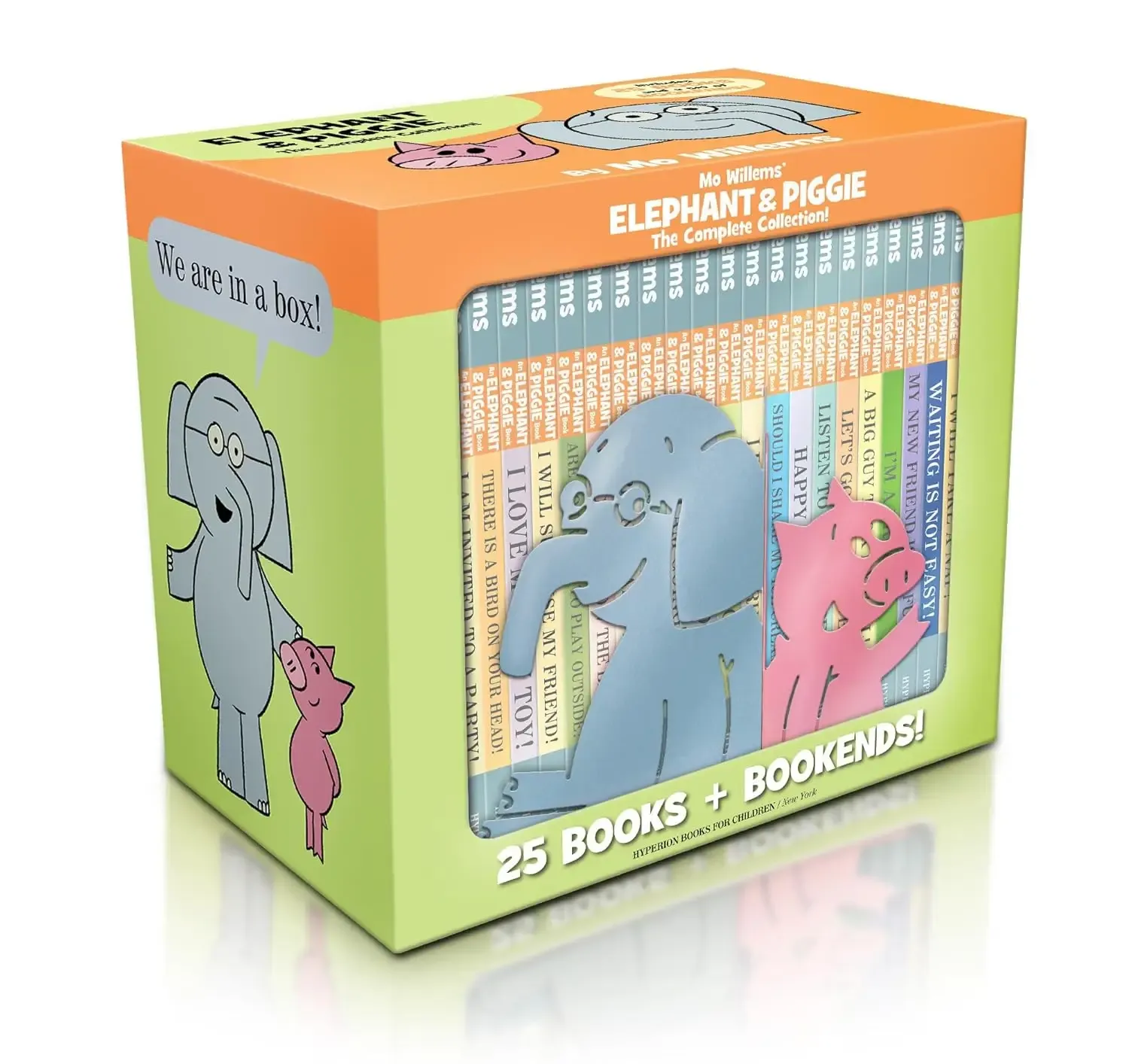Mo Willems’ Elephant and Piggie series is a collection of 25 delightfully humorous and heartwarming books that have become a staple in early childhood reading. Through the adventures of two lovable friends (Gerald the elephant and Piggie the pig) Willems has created a world where simple yet profound themes of friendship, empathy, problem-solving, and emotions take center stage. The books are ideal for beginning readers, thanks to their engaging illustrations, repetitive language, and lively humor, but they also offer deeper lessons for readers of all ages.
The dynamic between Gerald and Piggie is at the heart of the series. Gerald, a careful and sometimes anxious elephant, contrasts sharply with Piggie’s spontaneous, fun-loving nature. This classic “odd couple” pairing allows for plenty of playful tension, misunderstandings, and heartfelt resolutions that young readers find relatable. Throughout the series, the two characters demonstrate what it means to be a good friend, even when their differences lead to confusion or frustration. The back-and-forth between them often highlights real-life social dynamics, making these stories great conversation starters about emotions and social interactions.
Each book in the series has its own unique plot, but all are driven by simple, relatable situations that escalate into hilarious adventures. For example, in There Is a Bird on Your Head!, Gerald’s anxiety spirals as birds begin building a nest on his head, while Piggie finds the situation amusing. In We Are in a Book!, the characters become self-aware and hilariously interact with the reader, breaking the fourth wall. In Can I Play Too?, Gerald and Piggie’s attempt to include a snake in their ball game teaches a lesson about inclusion and creativity, as they figure out how to adapt the game to accommodate a friend with no arms. These kinds of stories reflect everyday concerns, sharing, inclusion, fear, disappointment, but present them in a light, digestible, and fun format.
One of the standout aspects of the series is its simplicity. Willems’ minimalistic art style, characterized by expressive lines and limited backgrounds, directs the reader’s focus on the characters and their emotions. The visual humor, such as exaggerated facial expressions or body language, enhances the reading experience and makes the books perfect for read-aloud sessions. The illustrations convey much of the emotional subtext, allowing even the youngest readers to understand what’s happening without needing too much text. This visual storytelling technique is part of what makes the Elephant and Piggie books so effective for early readers, children can “read” the story even before they fully grasp the words.
The repetitive, rhythmic text is another key feature that helps early readers develop confidence. Willems uses simple vocabulary and short sentences, often structured as a dialogue between Gerald and Piggie, which creates a conversational tone. This format makes the books approachable and fun, with plenty of opportunities for young readers to practice phrasing and expression as they read. The dialogue also allows children to engage actively with the characters, imagining themselves as part of the conversation.
Despite their simplicity, the Elephant and Piggie books offer depth. The humor is often layered, appealing both to children and the adults who may be reading along with them. Books like I Am Invited to a Party! or Should I Share My Ice Cream? address big feelings like excitement, jealousy, and indecision in ways that resonate with both kids and adults. In The Thank You Book, which serves as a touching conclusion to the series, Piggie’s desire to thank everyone she knows creates a sweet reflection on gratitude and friendship, with a twist that highlights Gerald’s unique way of thinking.
The series also excels in its pacing. The slow, deliberate build-up to a joke, coupled with the minimalistic style, makes each punchline land with just the right amount of impact. Willems is a master at using pauses, timing, and repetition to build tension and then release it in a way that keeps readers laughing out loud.
Throughout the series, the books convey important life lessons, without ever feeling didactic or heavy-handed. Each story subtly emphasizes the values of empathy, cooperation, problem-solving, and emotional awareness. Gerald and Piggie’s interactions show readers that it’s okay to be different, that mistakes can be fixed, and that friends support each other through ups and downs. This balance of fun and heart gives the series its timeless appeal.
Here’s a brief look at a few standout books from the series:
- Today I Will Fly!: The very first book introduces Piggie’s determination to fly and Gerald’s skepticism, offering an encouraging message about perseverance and optimism.
- I Am Invited to a Party!: Piggie is excited to attend a party, while Gerald’s over-preparation makes for a funny take on their contrasting personalities.
- There Is a Bird on Your Head!: A hilarious exploration of Gerald’s escalating panic and Piggie’s lighthearted approach, with an underlying message about letting go of worries.
- Elephants Cannot Dance!: Gerald struggles to accept that he can’t dance like Piggie, but in the end, Piggie shows him that everyone can find their own way of dancing, teaching acceptance of differences.
- The Thank You Book: The final book in the series wraps up Gerald and Piggie’s journey with a heartwarming message of gratitude, celebrating the friendships formed along the way.
The Elephant and Piggie series by Mo Willems is a treasure trove of humor, heart, and life lessons for young readers. Each book offers a unique, charming adventure that balances playful fun with valuable insights into friendship, emotions, and social interactions. Willems’ ability to create meaningful stories with minimal words and expressive illustrations makes this series a perfect choice for beginner readers, while the humor and depth ensure that these books are just as enjoyable for parents, teachers, and older readers.
Add this book to your library:More books by Mo Willems:
 City Dog, Country Frog
City Dog, Country Frog





